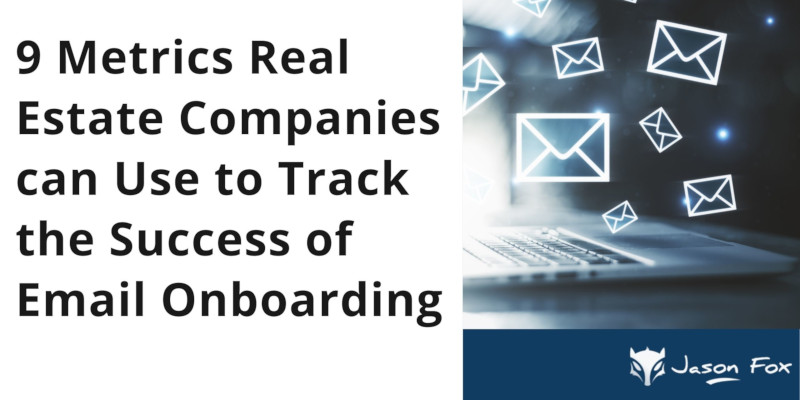9 Metrics Real Estate Companies can Use to Track the Success of Email Onboarding
The value of a product is being recognized when a customer starts using it, and in the real estate industry, there are many “products” that you can use to reel in qualified buyers. Your listings might be your main products, but a real estate company can use a number of different complementary products and services to enrich the customer’s experience.
Typically, customer onboarding would represent the period after a customer has made a purchase and is acquiring knowledge about your product. In the real estate sector, however, customer onboarding starts the moment you generate a qualified lead, given the longer sales cycle and the fact that buyers need to go through multiple stages of the sales pipeline.
You need to ensure the buyer has entered the email onboarding phase ASAP so that you can begin the value-driven adoption phase. In other words, real estate companies can sell more and build brand authority by delivering value through email onboarding.
To achieve successful onboarding, you should know customers’ expectations and their overall goals. Clients will rely on you and your support if this is new and completely unknown territory for them.
In the real estate field, you need to track buyer email onboarding metrics in order to gauge the efficacy of your lead nurturing and your email communication as a whole. This will produce more satisfied prospects and will help them convert quickly.
Therefore, let’s check the nine metrics of tracking the success of email onboarding:
Email Onboarding Time
Once you’ve generated leads and interested buyers using your inbound tools of choice, the first and initial step is the onboarding phase. Here, potential buyers should get to know your brand and your values, as well as some of your listings, curated for their needs. Your job is to create a clear value proposition from the start, resonate with their values and needs, and establish a trusting relationship.
This will help your real estate business capture qualified leads and start nurturing them until they decide to buy a property.
Measuring the email onboarding time will be key. So, make sure you know how much time has passed from the first time a customer has come in contact with your brand. This is the start of your email onboarding phase, and knowing the exact time can help you with your performance. This way, you can improve your efficiency, and you can improve the onboarding time with each new customer by refining the process.
The aim is to make the onboarding time short yet effective and valuable for the property buyer and their needs. Helping them to better understand their own needs, their local real estate market, and the services and listings on offer will be crucial here – but it takes time.
When it comes to onboarding new real estate agents at your company, on the other hand, showing them these practical steps and teaching them to implement customer onboarding strategies can benefit them and the company as a whole.
This can help the entire customer success team shorten the time of an onboarding phase, and help you get more buyers to begin the property procurement process.
To measure email onboarding time, simply track the time it took to get from the first email exchange to reaching a goal.
Some of your email goals can be:
- Selling a property – top level goal.
- Building brand awareness and trust.
- Educating the prospects.
- Building social proof.
- Generating more qualified leads.
- Driving traffic to your website or social media.
Customer Engagement

It’s not unusual that the potential buyer has misunderstood something, especially if it’s via mail. You need to clear up the confusion before moving on to the next step. Guiding the customers on this journey is the primary step in onboarding, especially when you’re using email communication to nurture real estate leads.
Time to First Value (TTFV)
The onboarding process is complete when a potential buyer or a new brand advocate has internalized your values and believes in your brand. This is called time to first value or TTFV, which emphasizes all the good attributes of your brand. When communicating via email, you need to personalize your approach according to the needs of the buyer, while emphasizing the value your real estate company brings to the table.
Your job is not only to educate the buyer, but also to aid their decision-making process while allowing them to extract real-world value from your brand and your services.
To achieve this, you will:
- Get to know the potential buyer and create a personalized approach based on their buyer persona.
- Curate your listings and your offering according to their specific needs.
- Provide valuable information they can use in their search for the perfect property, as well as real-world information they need to become successful homeowners.
- Continue delivering value through diligent support and valuable content.
Doing this will satisfy the customers’ needs for the first time in their search for their new home, allowing them to realize the full value of your brand, your knowledge of the market, and your professional services as a real estate company.
Free Trial to Paid Conversion

Ultimately, your goal is to sell property, buy to expedite this process and attract high-paying buyers, you need to establish a connection with the individual.
Perhaps the most effective way to achieve this is to offer free knowledge, guidance, consultations, real estate insights, and more. This is one of the most powerful marketing and sales strategies for real estate companies that are focusing on email strategies.
It’s also one of the best ways to boost your brand’s value and offer more value to your prospective buyers without them feeling like they need to commit before they are ready.
How can you know if the free services were effective?
Everything that you provide to prospective customers for free via email should help you achieve a certain goal. You should refer back to the email goals we mentioned above to be able to gauge whether or not your free efforts have been successful.
In real estate, you can consider your free services and products a success if you manage to transform a lead into a buyer, or if you achieve any of the complementary goals. This can include building brand awareness and authority in your area, boosting word of mouth, and more.
Customer Progression
After some of your leads have commissioned your services and after you’ve thanked them for their purchase and trust, it’s time to move on to customer progression. It is a part of the onboarding process and also an indicator of time to completion. When you are giving the necessary information, make sure they are presented in a concise and easy-to-understand way.
This is also known as customer training, which will help solidify your relationship and will go a long way in boosting your word of mouth.
You can provide buyers with online material through email, allowing them to learn independently by themselves. Alternatively, you can directly engage with them in one-on-one conversation and provide them with the guidance and support they need to become thriving homeowners.
For instance, you can provide different types of learning materials on anything that a future homeowner or property owner might need to know. Instructional videos, how to articles, or even a section of frequently asked questions – all of this can improve the customers’ educational process and add value to your email communication.
In any case, the important thing is to measure the time you are spending on the prospect until they ultimately purchase a property – and become satisfied buyers who would recommend your services to someone else.
Remember not to leave anything unexplained from the customers’ side. If this happens, there’s a big chance that the prospect will reach out for help at another real estate company or an independent real estate expert, which can cost you. Worse, they’ll just leave and you lose customers at a moment’s notice.
Customer Response Rate
As mentioned above, buyers can run into numerous obstacles and will require help during their home buying journey. That’s why it’s essential to provide feedback forums, send email surveys, and document frequently asked questions.
Also, it’s vital to personalize all the emails you send to prospects, which helps improve the response rate. You can do this by including GIFs in your emails, which could raise engagement rates by up to 150%. Consider including your email signatures as well with links to your socials and a page on your site where they can ask you questions.
By tracking these, you can balance benchmarked norms that will provide insights into how well you are meeting your customers’ needs in the competitive real estate sector. For instance, monitoring the email signature CTR lets you know how effective the signature is and what you must do to improve its performance.
Using the gathered data, you can make an informed decision regarding your current practices in communication with potential buyers.
Escalation Response Time

Escalation response time is the time you will need from the moment a prospect files a complaint to the moment you resolve the issue. The way you respond and handle customers’ complaints massively affects their loyalty. No matter if the complaint was via mail, call, or even in person, when and how you are responding is crucial at this point.
Plus, real estate customers want immediate responses, so there’s no room for delays. If this happens, it will impact the time it takes new customers to develop a relationship with their real estate agent, which will significantly prolong the sales cycle. So, keep in mind that the escalation response time is a crucial part of the whole onboarding process.
Just as you are active with your outreach strategy, you also need to be responsive by giving them a solution on a short notice and resolving any issues within 24 hours. By doing so, your agents and your brand as a whole will make a good impression on prospective buyers.
Adoption Rate
One of the most important metrics is the adoption rate, which tells you the success of onboarding itself. Product adoption rate measures effectiveness and the engagement customers have with your real estate brand, your services, and ultimately the properties you’re selling.
You can determine that simply by knowing the time and length the customer has spent in contact with your agents and the steps they have taken towards property procurement or any other goal.
There are a few metrics that can help you measure the adoption rate. You can determine the adoption rate by checking in with your prospects to see how valuable your services and guidance have been so far. You can do this via direct communication or by sending out surveys and questionnaires.
You can also measure the adoption rate by monitoring your email success rates, for example how many people are opening and responding to your emails, how engaged they are in the conversation, and more. Keep in mind that the adoption rate will be higher if the prospects feel engaged and valued.
Milestones Completed

Additionally, completing milestones will lead to increased brand adoption and will lead prospects towards positive outcomes. That’s why it’s crucial to have an email onboarding checklist to ensure that every potential buyer will get a seamless and enjoyable onboarding experience.
At the same time, the number of milestones the buyer has completed will tell you how effective your email onboarding strategy is. Based on the results, you should gain insights into your email campaign and adapt your approach to improve your customer onboarding emails.
Conclusion
Each step is equally important for tracking the success of onboarding and email marketing in general.
Optimizing your email onboarding phase will make the entire process more efficient and effective for your real estate agents, which will help guide prospective buyers towards your goals. If the customer adopts your brand and finds value in your services quickly, they will have no problem becoming your loyal brand advocates.
That is why it’s important to keep detailed records of your email onboarding. Only then can you perform a flawless onboarding process, which will help you stand out in the competitive real estate sector and provide more value to every potential buyer.
post contents
The value of a product is being recognized when a customer starts using it, and in the real estate industry, there are many “products” that you can use to reel in qualified buyers. Your listings might be your main products, but a real estate company can use a number of different complementary products and services to enrich the customer’s experience.
Typically, customer onboarding would represent the period after a customer has made a purchase and is acquiring knowledge about your product. In the real estate sector, however, customer onboarding starts the moment you generate a qualified lead, given the longer sales cycle and the fact that buyers need to go through multiple stages of the sales pipeline.
You need to ensure the buyer has entered the email onboarding phase ASAP so that you can begin the value-driven adoption phase. In other words, real estate companies can sell more and build brand authority by delivering value through email onboarding.
To achieve successful onboarding, you should know customers’ expectations and their overall goals. Clients will rely on you and your support if this is new and completely unknown territory for them.
In the real estate field, you need to track buyer email onboarding metrics in order to gauge the efficacy of your lead nurturing and your email communication as a whole. This will produce more satisfied prospects and will help them convert quickly.
Therefore, let’s check the nine metrics of tracking the success of email onboarding:
Email Onboarding Time
Once you’ve generated leads and interested buyers using your inbound tools of choice, the first and initial step is the onboarding phase. Here, potential buyers should get to know your brand and your values, as well as some of your listings, curated for their needs. Your job is to create a clear value proposition from the start, resonate with their values and needs, and establish a trusting relationship.
This will help your real estate business capture qualified leads and start nurturing them until they decide to buy a property.
Measuring the email onboarding time will be key. So, make sure you know how much time has passed from the first time a customer has come in contact with your brand. This is the start of your email onboarding phase, and knowing the exact time can help you with your performance. This way, you can improve your efficiency, and you can improve the onboarding time with each new customer by refining the process.
The aim is to make the onboarding time short yet effective and valuable for the property buyer and their needs. Helping them to better understand their own needs, their local real estate market, and the services and listings on offer will be crucial here – but it takes time.
When it comes to onboarding new real estate agents at your company, on the other hand, showing them these practical steps and teaching them to implement customer onboarding strategies can benefit them and the company as a whole.
This can help the entire customer success team shorten the time of an onboarding phase, and help you get more buyers to begin the property procurement process.
To measure email onboarding time, simply track the time it took to get from the first email exchange to reaching a goal.
Some of your email goals can be:
- Selling a property – top level goal.
- Building brand awareness and trust.
- Educating the prospects.
- Building social proof.
- Generating more qualified leads.
- Driving traffic to your website or social media.
Customer Engagement

It’s not unusual that the potential buyer has misunderstood something, especially if it’s via mail. You need to clear up the confusion before moving on to the next step. Guiding the customers on this journey is the primary step in onboarding, especially when you’re using email communication to nurture real estate leads.
Time to First Value (TTFV)
The onboarding process is complete when a potential buyer or a new brand advocate has internalized your values and believes in your brand. This is called time to first value or TTFV, which emphasizes all the good attributes of your brand. When communicating via email, you need to personalize your approach according to the needs of the buyer, while emphasizing the value your real estate company brings to the table.
Your job is not only to educate the buyer, but also to aid their decision-making process while allowing them to extract real-world value from your brand and your services.
To achieve this, you will:
- Get to know the potential buyer and create a personalized approach based on their buyer persona.
- Curate your listings and your offering according to their specific needs.
- Provide valuable information they can use in their search for the perfect property, as well as real-world information they need to become successful homeowners.
- Continue delivering value through diligent support and valuable content.
Doing this will satisfy the customers’ needs for the first time in their search for their new home, allowing them to realize the full value of your brand, your knowledge of the market, and your professional services as a real estate company.
Free Trial to Paid Conversion

Ultimately, your goal is to sell property, buy to expedite this process and attract high-paying buyers, you need to establish a connection with the individual.
Perhaps the most effective way to achieve this is to offer free knowledge, guidance, consultations, real estate insights, and more. This is one of the most powerful marketing and sales strategies for real estate companies that are focusing on email strategies.
It’s also one of the best ways to boost your brand’s value and offer more value to your prospective buyers without them feeling like they need to commit before they are ready.
How can you know if the free services were effective?
Everything that you provide to prospective customers for free via email should help you achieve a certain goal. You should refer back to the email goals we mentioned above to be able to gauge whether or not your free efforts have been successful.
In real estate, you can consider your free services and products a success if you manage to transform a lead into a buyer, or if you achieve any of the complementary goals. This can include building brand awareness and authority in your area, boosting word of mouth, and more.
Customer Progression
After some of your leads have commissioned your services and after you’ve thanked them for their purchase and trust, it’s time to move on to customer progression. It is a part of the onboarding process and also an indicator of time to completion. When you are giving the necessary information, make sure they are presented in a concise and easy-to-understand way.
This is also known as customer training, which will help solidify your relationship and will go a long way in boosting your word of mouth.
You can provide buyers with online material through email, allowing them to learn independently by themselves. Alternatively, you can directly engage with them in one-on-one conversation and provide them with the guidance and support they need to become thriving homeowners.
For instance, you can provide different types of learning materials on anything that a future homeowner or property owner might need to know. Instructional videos, how to articles, or even a section of frequently asked questions – all of this can improve the customers’ educational process and add value to your email communication.
In any case, the important thing is to measure the time you are spending on the prospect until they ultimately purchase a property – and become satisfied buyers who would recommend your services to someone else.
Remember not to leave anything unexplained from the customers’ side. If this happens, there’s a big chance that the prospect will reach out for help at another real estate company or an independent real estate expert, which can cost you. Worse, they’ll just leave and you lose customers at a moment’s notice.
Customer Response Rate
As mentioned above, buyers can run into numerous obstacles and will require help during their home buying journey. That’s why it’s essential to provide feedback forums, send email surveys, and document frequently asked questions.
Also, it’s vital to personalize all the emails you send to prospects, which helps improve the response rate. You can do this by including GIFs in your emails, which could raise engagement rates by up to 150%. Consider including your email signatures as well with links to your socials and a page on your site where they can ask you questions.
By tracking these, you can balance benchmarked norms that will provide insights into how well you are meeting your customers’ needs in the competitive real estate sector. For instance, monitoring the email signature CTR lets you know how effective the signature is and what you must do to improve its performance.
Using the gathered data, you can make an informed decision regarding your current practices in communication with potential buyers.
Escalation Response Time

Escalation response time is the time you will need from the moment a prospect files a complaint to the moment you resolve the issue. The way you respond and handle customers’ complaints massively affects their loyalty. No matter if the complaint was via mail, call, or even in person, when and how you are responding is crucial at this point.
Plus, real estate customers want immediate responses, so there’s no room for delays. If this happens, it will impact the time it takes new customers to develop a relationship with their real estate agent, which will significantly prolong the sales cycle. So, keep in mind that the escalation response time is a crucial part of the whole onboarding process.
Just as you are active with your outreach strategy, you also need to be responsive by giving them a solution on a short notice and resolving any issues within 24 hours. By doing so, your agents and your brand as a whole will make a good impression on prospective buyers.
Adoption Rate
One of the most important metrics is the adoption rate, which tells you the success of onboarding itself. Product adoption rate measures effectiveness and the engagement customers have with your real estate brand, your services, and ultimately the properties you’re selling.
You can determine that simply by knowing the time and length the customer has spent in contact with your agents and the steps they have taken towards property procurement or any other goal.
There are a few metrics that can help you measure the adoption rate. You can determine the adoption rate by checking in with your prospects to see how valuable your services and guidance have been so far. You can do this via direct communication or by sending out surveys and questionnaires.
You can also measure the adoption rate by monitoring your email success rates, for example how many people are opening and responding to your emails, how engaged they are in the conversation, and more. Keep in mind that the adoption rate will be higher if the prospects feel engaged and valued.
Milestones Completed

Additionally, completing milestones will lead to increased brand adoption and will lead prospects towards positive outcomes. That’s why it’s crucial to have an email onboarding checklist to ensure that every potential buyer will get a seamless and enjoyable onboarding experience.
At the same time, the number of milestones the buyer has completed will tell you how effective your email onboarding strategy is. Based on the results, you should gain insights into your email campaign and adapt your approach to improve your customer onboarding emails.
Conclusion
Each step is equally important for tracking the success of onboarding and email marketing in general.
Optimizing your email onboarding phase will make the entire process more efficient and effective for your real estate agents, which will help guide prospective buyers towards your goals. If the customer adopts your brand and finds value in your services quickly, they will have no problem becoming your loyal brand advocates.
That is why it’s important to keep detailed records of your email onboarding. Only then can you perform a flawless onboarding process, which will help you stand out in the competitive real estate sector and provide more value to every potential buyer.
Latest articles
Short real estate videos can be transformed into powerful blog content with the right strategy. Learn how to expand on video topics, incorporate SEO best practices, and create engaging posts that drive traffic and boost your search rankings.
Learn how to create real estate community pages that attract buyers, boost your local SEO, and establish you as a market expert. This ultimate guide covers content creation tips, the use of AI tools, and IDX integration to help your pages stand out in 2024.
To stay competitive in real estate, agents must prioritize SEO to improve their Google visibility. By implementing proven strategies like asking for reviews, creating relevant content, and focusing on local SEO, you can attract more clients and increase your online presence.
BECOME A MEMBER
Become A Free DIY Real Estate Marketing Member & Get Access To:
LARGEST COLLECTION OF
Real Estate Marketing e-Books, Guides, Templates, & whitepapers
ON THE INTERNET
+ OVER 70 How To Website Training Videos including; WordPress, Agent Evolution Themes, & IDX Broker
+ DIY Real Estate Marketing Tips and Strategies Delivered to Your Inbox
Share this article
Written by : jasonfox
Jason Fox - Real Estate Marketing
Business: We build WordPress Real Estate Websites with IDX
Me: #GoHawks, #BringBackTheSonics, #MaybeNextYearMariners, #ILoveMyKids #SeattleSunLover #SeattleWaterLover #BFF
Blog: Focuses on Wordpress Websites, Content Management, SEO Services, SEM Campaigns, Social Media Marketing, Email Marketing, Beautiful Design, IDX, and more.





